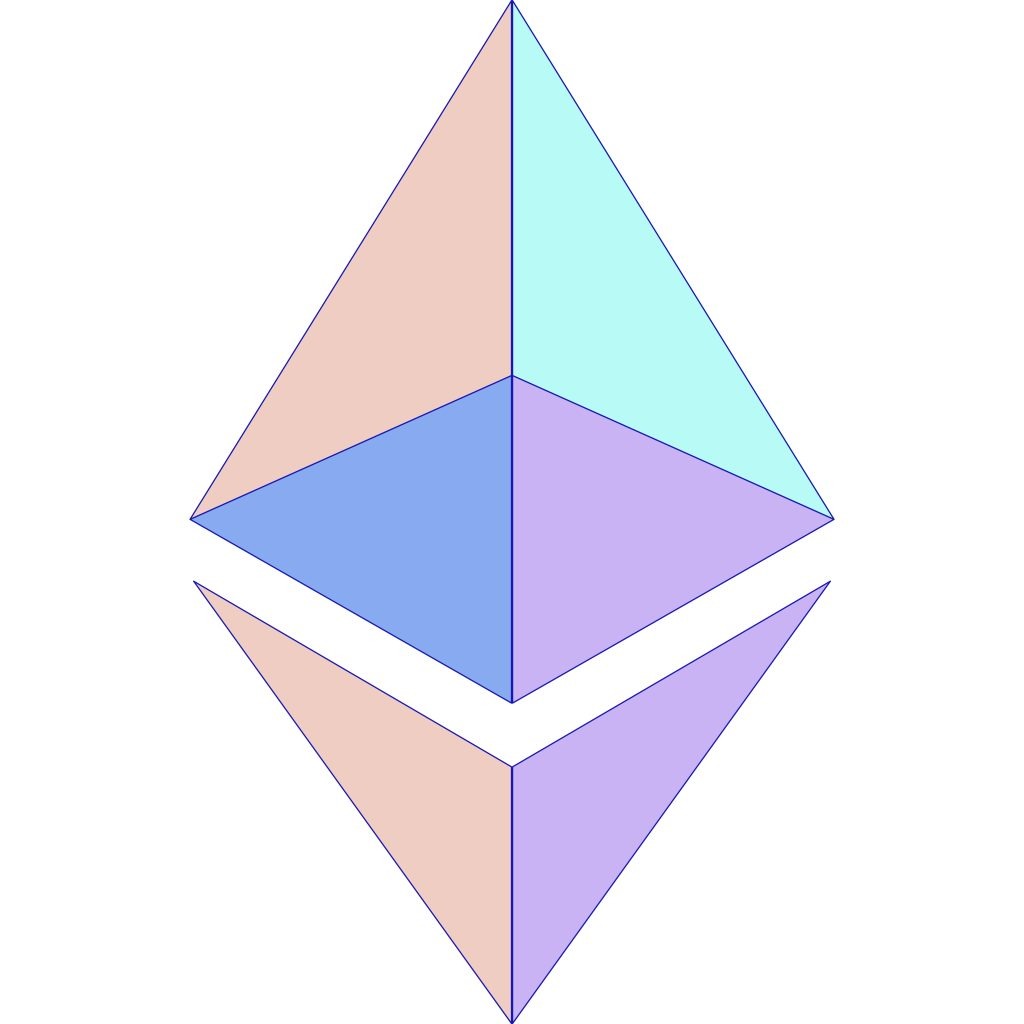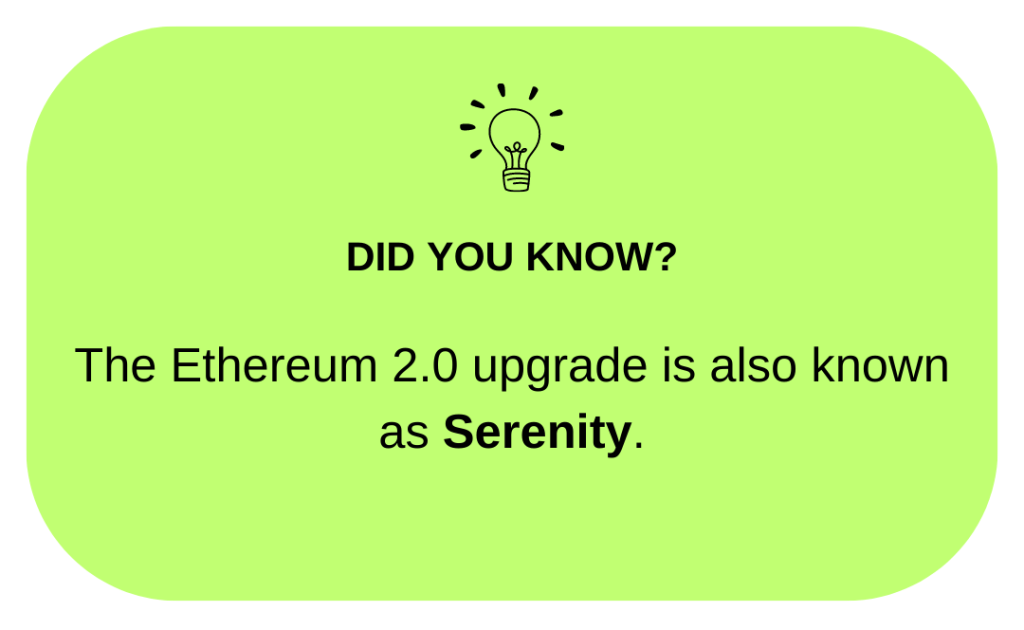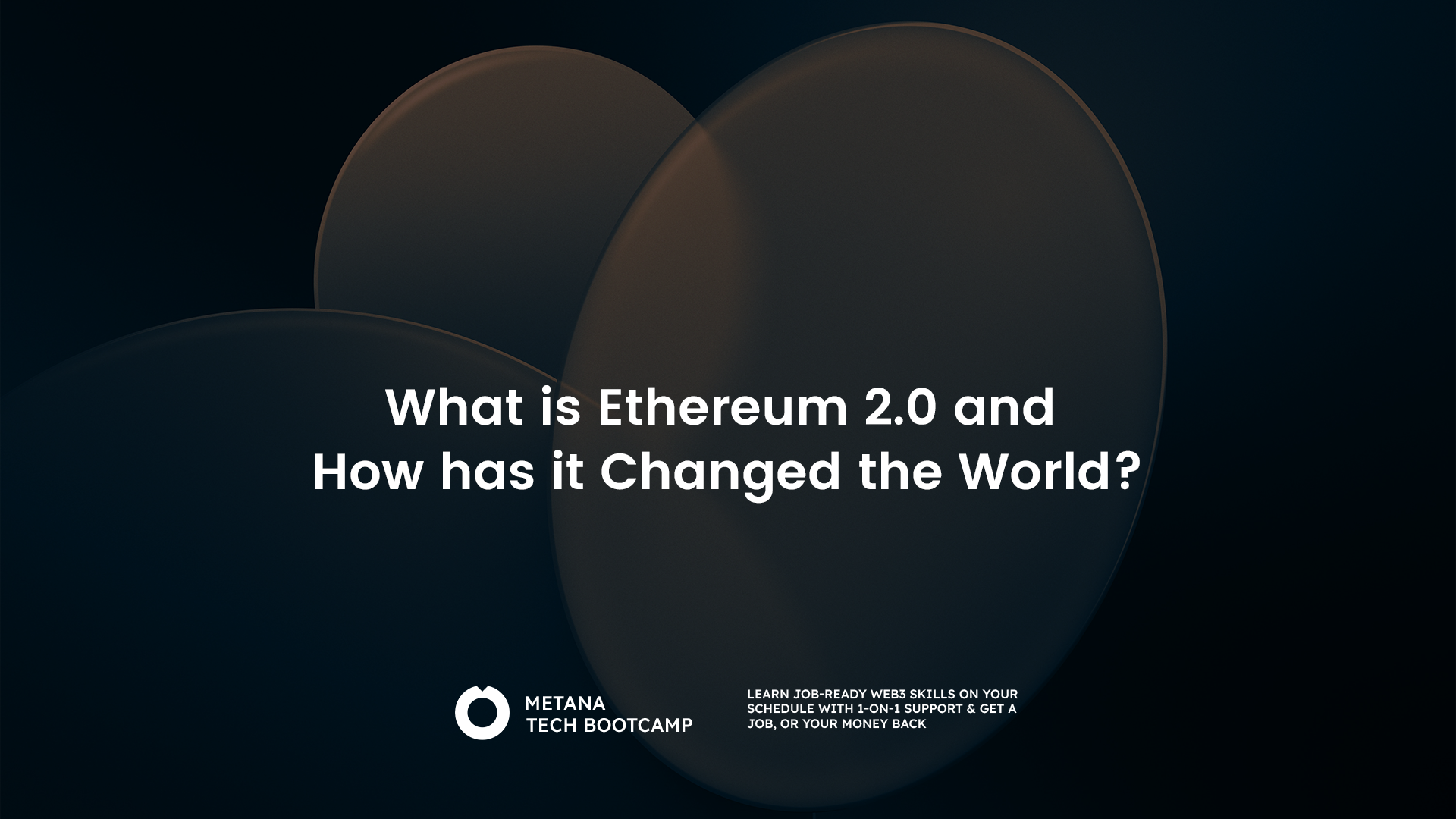Ever been annoyed by how slow a webpage loads? Or felt worried about making an online transaction because of safety issues? Well, Ethereum 2.0 is here to fix those problems and more! This new update is making Ethereum faster and safer than before. It’s like a makeover for Ethereum, bringing quicker transactions, better security, and the ability to handle more users at once. In this article, we’re going to dive into what Ethereum 2.0 really is and what it means for the future of this super popular cryptocurrency.

What is Ethereum 2.0?
Ethereum 2.0 is a significant update to the world’s second-largest cryptocurrency network that takes advantage of proof-of-stake consensus mechanism, providing users with faster transaction times and lower fees.
The goals of Ethereum 2.0 are to:
- Increase scalability: Ethereum 1.0 can currently only process about 15 transactions per second (TPS). Ethereum 2.0 aims to increase this to 100,000 TPS or more. This will make Ethereum much more suitable for applications that require high throughput, such as decentralized finance (DeFi) and gaming.
- Improve security: Ethereum 1.0 is vulnerable to attack because it uses a proof-of-work (PoW) consensus mechanism. PoW requires miners to compete with each other to solve complex mathematical problems in order to add blocks to the blockchain. This can be expensive and energy-intensive, and it also makes the network vulnerable to attacks by malicious actors. Ethereum 2.0 will use a proof-of-stake (PoS) consensus mechanism, which is more secure and energy-efficient.
- Make Ethereum more sustainable: Ethereum 1.0 consumes a lot of energy. The transition to PoS will significantly reduce Ethereum’s energy consumption. This will make Ethereum more sustainable and environmentally friendly.
In addition to these three main goals, Ethereum 2.0 also aims to:
- Make Ethereum more decentralized: Ethereum 1.0 is currently somewhat centralized, with a small number of miners controlling the majority of the network. Ethereum 2.0 will make the network more decentralized by making it easier for anyone to participate as a validator.
- Make Ethereum more user-friendly: Ethereum 1.0 can be difficult to use for non-technical users. Ethereum 2.0 will make the network more user-friendly by providing a simpler user interface and improved documentation.
The development of Ethereum 2.0 is still ongoing, but it is making significant progress. The Beacon Chain, which is the first phase of Ethereum 2.0, was launched in December 2020. The Merge, which merges the Beacon Chain with the Ethereum mainnet, happened in September 2022. As the Merge is completed, it will be fully operational and has begun to deliver on its promise of scalability, security, and sustainability.

What are the Technical Features of Ethereum 2.0?
Proof of Stake Consensus Mechanism
Proof-of-stake (PoS) is a consensus mechanism used by some cryptocurrencies to validate transactions and add new blocks to the blockchain. In PoS, validators are randomly selected to verify transactions and add blocks to the blockchain based on the amount of cryptocurrency they stake. Staking is the process of locking up cryptocurrency in a smart contract to participate in the consensus mechanism.
Validators are rewarded with cryptocurrency for verifying transactions and adding blocks to the blockchain. The more cryptocurrency a validator stakes, the more likely they are to be selected to validate transactions and add blocks. This makes PoS more energy-efficient than proof-of-work (PoW), which is the consensus mechanism used by Bitcoin and many other cryptocurrencies. PoS is also more secure than PoW because validators have a financial incentive to keep the network secure.
Overall, PoS is a more energy-efficient and secure consensus mechanism than PoW. This makes it a good choice for cryptocurrencies that want to be more environmentally friendly and resistant to attacks.
| How it works | Proof of Work (PoW) | Proof of Stake (PoS) |
|---|---|---|
| Basic Concept | Miners solve complex mathematical problems to add a new block to the blockchain. The first to solve it adds the block and gets rewarded. | Users create new blocks and validate transactions based on the number of coins they hold and are willing to ‘stake’ as collateral. |
| Energy Consumption | High; solving the problems requires significant computational power and energy. | Low; the process doesn’t require high computational power, so it consumes less energy. |
| Security | High; changing past data requires redoing all the work that comes after it, which is practically impossible. | High; an attacker would need 51% of all staked coins, which is expensive and unlikely. |
| Decentralization | Initially high, but can decrease as mining operations grow larger and more centralized. | Depends on various factors. If most coins are held by a few, it can lead to centralization. |
| Reward Distribution | Rewards go to miners who solve the problems fastest, which often requires expensive hardware. | Rewards are given to those who hold more coins and are willing to stake them, favoring wealthier users. |
| Block Creation Speed | Fixed according to the difficulty of the mathematical problems. | Can be quicker and more consistent as it’s not based on solving a problem but on staking amount and coin age. |
Sharding
Sharding is a technique used to improve the scalability of blockchain networks by dividing the network into smaller pieces called shards. Each shard can process transactions independently, which allows the network to process more transactions per second without sacrificing security or decentralization. Sharding is a promising solution to the scalability problem facing blockchain networks, and it is expected to be adopted by many more networks in the future.
In short, sharding is a way to divide a blockchain network into smaller pieces, each of which can process transactions independently. This can improve the scalability of the network, allowing it to process more transactions per second. Sharding is a promising technology that is being adopted by some blockchain networks, and it is expected to become more widespread in the future.
Beacon Chain
The Beacon Chain is a new layer on the Ethereum network that will coordinate the shards and ensure the security of the network. It uses a proof-of-stake consensus mechanism, which makes it more energy-efficient and less susceptible to attacks than the current Ethereum mainnet. The Beacon Chain is a key part of the Ethereum 2.0 upgrade, which will make Ethereum more scalable, secure, and energy-efficient.
State Channels
State channels are a way to reduce the amount of data that needs to be transferred on a blockchain network. This can improve scalability and reduce transaction fees. State channels allow two parties to make a series of transactions without broadcasting them to the entire network. Instead, the transactions are only recorded on the state channel. Once the parties are finished with the transactions, they can broadcast the final state of the channel to the blockchain network.
State channels are a promising technology that can improve the scalability and efficiency of blockchain networks. They are already being used by some blockchain networks, such as Raiden Network and Lightning Network.
EVM Upgrade
The EVM upgrade is a major milestone in the development of Ethereum. It will make Ethereum more scalable, secure, and efficient by improving the Ethereum Virtual Machine (EVM). The EVM is the software that runs on Ethereum nodes and executes smart contracts. The EVM upgrade will make the EVM more efficient by using a new bytecode format and by optimizing the execution of smart contracts. It will also make the EVM more secure by adding new security features, such as gas metering and stack depth limits. The EVM upgrade is backward compatible with existing smart contracts, so developers will not need to make any changes to their smart contracts when the upgrade is implemented.
What are the Benefits of Ethereum 2.0?
Increased scalability:
Ethereum 2.0 will be able to process more transactions per second than the current Ethereum network. This is due to the introduction of shard chains, which will divide the network into 64 smaller chains. This will allow the network to process up to 100,000 transactions per second, compared to the current Ethereum network’s capacity of 15-30 transactions per second.
Improved security:
Ethereum 2.0 will be more secure than the current Ethereum network thanks to the use of Proof-of-Stake consensus. Proof-of-Stake is a more energy-efficient and secure consensus mechanism than Proof-of-Work, which is the current consensus mechanism used by Ethereum.
Reduced energy consumption:
Ethereum 2.0 will consume less energy than the current Ethereum network thanks to the use of Proof-of-Stake consensus. Proof-of-Stake requires validators to stake their ETH tokens in order to participate in the consensus mechanism. This staking process requires much less energy than the mining process used by Proof-of-Work.
Increased decentralization:
Ethereum 2.0 will be more decentralized than the current Ethereum network thanks to the use of sharding. Sharding will allow more nodes to participate in the consensus mechanism, which will make the network more resistant to attack.
Overall, Ethereum 2.0 is a major upgrade that will make the Ethereum blockchain more scalable, secure, sustainable, and decentralized. These improvements will make Ethereum a more attractive platform for developers and users of decentralized applications.
What are the Challenges of Ethereum 2.0?
Ethereum 2.0 is a major upgrade to the Ethereum blockchain that aims to improve its scalability, security, and sustainability. However, it faces a number of challenges, including:
Complexity:
Ethereum 2.0 is a complex upgrade, and it will be challenging to implement it without any bugs. The upgrade is made up of a number of different components, and it will be difficult to ensure that they all work together seamlessly. This could lead to bugs and other problems that could disrupt the network.
Security:
Ethereum 2.0 will be more secure than the current Ethereum network, but it will still be vulnerable to attack. The upgrade will introduce a number of new security features, but it is still possible that it could be hacked. This is a major concern for developers and users who are considering using Ethereum 2.0.
Decentralization:
Ethereum 2.0 will be more decentralized than the current Ethereum network, but it will still be centralized to some degree. This is because a small number of validators will control a large share of the network’s stake. This could make the network vulnerable to attack.
Interoperability:
Ethereum 2.0 will need to be interoperable with other blockchains in order to achieve its full potential. The upgrade will need to be able to communicate with other blockchains, but it is not yet clear how Ethereum 2.0 will achieve this.
Adoption:
Ethereum 2.0 will need to be adopted by developers and users in order to be successful. This will require developers to build applications on Ethereum 2.0, and it will require users to use those applications. It is not yet clear if Ethereum 2.0 will be adopted by developers and users in sufficient numbers.
Despite these challenges, Ethereum 2.0 has the potential to be a major upgrade for the Ethereum blockchain. If the upgrade is successful, it could make Ethereum the most scalable, secure, and decentralized blockchain in the world.
What does the Future Hold for Ethereum 2.0?
The future of Ethereum 2.0 is bright. The upgrade has the potential to make Ethereum the most scalable, secure, and decentralized blockchain in the world. This could make Ethereum a more attractive platform for developers and users of decentralized applications.
Here are some of the things that could happen in the future of Ethereum 2.0:
- The network could become more popular: Ethereum 2.0 could become more popular as it becomes more scalable, secure, and decentralized. This could lead to an increase in the number of developers and users using the network.
- The network could become more valuable: As the network becomes more popular, it could also become more valuable. This could lead to an increase in the price of ETH, the native cryptocurrency of Ethereum.
- The network could be used for more applications: Ethereum 2.0 could be used for a wider range of applications as it becomes more scalable and secure. This could include things like decentralized finance (DeFi), non-fungible tokens (NFTs), and gaming.
- The network could become more interoperable: Ethereum 2.0 could become more interoperable with other blockchains. This could allow users to transfer assets between different blockchains more easily.
- The network could become more decentralized: Ethereum 2.0 could become more decentralized as more nodes participate in the consensus mechanism. This could make the network more resistant to attack.
Overall, the future of Ethereum 2.0 is bright. The upgrade has the potential to make Ethereum a more scalable, secure, and decentralized blockchain in the world. This could make Ethereum a more attractive platform for developers and users of decentralized applications.

1.What is Ethereum 2.0
Ethereum 2.0 is a major upgrade to the Ethereum blockchain network. It is designed to improve the scalability, security, and energy efficiency of the network. Ethereum 2.0 will use a proof-of-stake (PoS) consensus mechanism instead of the current proof-of-work (PoW) mechanism. This will make the network more decentralized and environmentally friendly.
2.Will Ethereum 2.0 replace Ethereum?
No, Ethereum 2.0 will not replace Ethereum. Rather, it will be merged with the existing Ethereum blockchain to create a more scalable, secure, and efficient network. The two blockchains are merged together in a process called “The Merge.”
3.Will ETH 2.0 reduce gas fees?
The expected reduction of gas fees due to Ethereum 2.0 is uncertain, and may depend on various factors such as transaction complexity, network usage, and technical considerations.
4.How will Ethereum 2.0 affect price?
Ethereum 2.0 on price is uncertain and may depend on various factors such as the adoption rate, market sentiment, and competition from other cryptocurrencies and platforms, among other factors. While some in the community believe that Ethereum 2.0 will result in a price increase due to its increased scalability and energy efficiency, others believe that the market may be unpredictable and volatile, making it difficult to predict exactly how the upgrade will affect Ethereum prices.
5.What will happen to my ETH tokens when Ethereum 2.0 is released?
Your ETH tokens will be safe when Ethereum 2.0 is released. They will be migrated to the new network and you will be able to use them as you do today.
6.Should I invest in Ethereum 2.0?
Whether or not you should invest in Ethereum 2 depends on your investment goals and risk tolerance. If you are looking for a long-term investment, then Ethereum 2 may be a good option. However, it is important to do your own research and understand the risks before investing in any cryptocurrency.
7.How does Ethereum 2.0 differ from Ethereum 1.0?
Ethereum 2.0 represents a significant upgrade to Ethereum 1.0, with several improvements including proof-of-stake consensus, sharding, and other features designed to increase scalability, security, and sustainability. Additionally, it is expected to have better gas fees, faster transaction confirmation times, and a more energy-efficient network.
8.How can I stake ETH on Ethereum 2.0?
Staking is the process of locking up your ETH to help secure the Ethereum 2.0 network. You can stake your ETH through a number of different staking providers.
9.What are the risks of staking ETH on Ethereum 2.0?
There are a few risks associated with staking ETH on Ethereum 2.0. These risks include:
- The possibility of losing your ETH if the network is hacked.
- The possibility of losing your ETH if you are slashed for misbehavior.
- The possibility of earning lower rewards than expected.
10.When will Ethereum 2.0 be released?
There are varying estimates on the release date for Ethereum 2.0. Some sources suggest that the full release of Ethereum 2.0 is expected in 2023 1, while others mention a potential release in September 2022 or March 2023 for specific upgrades. However, it’s important to note that the Ethereum development community is constantly making progress, and the release date for Ethereum 2.0 may change as development continues.





